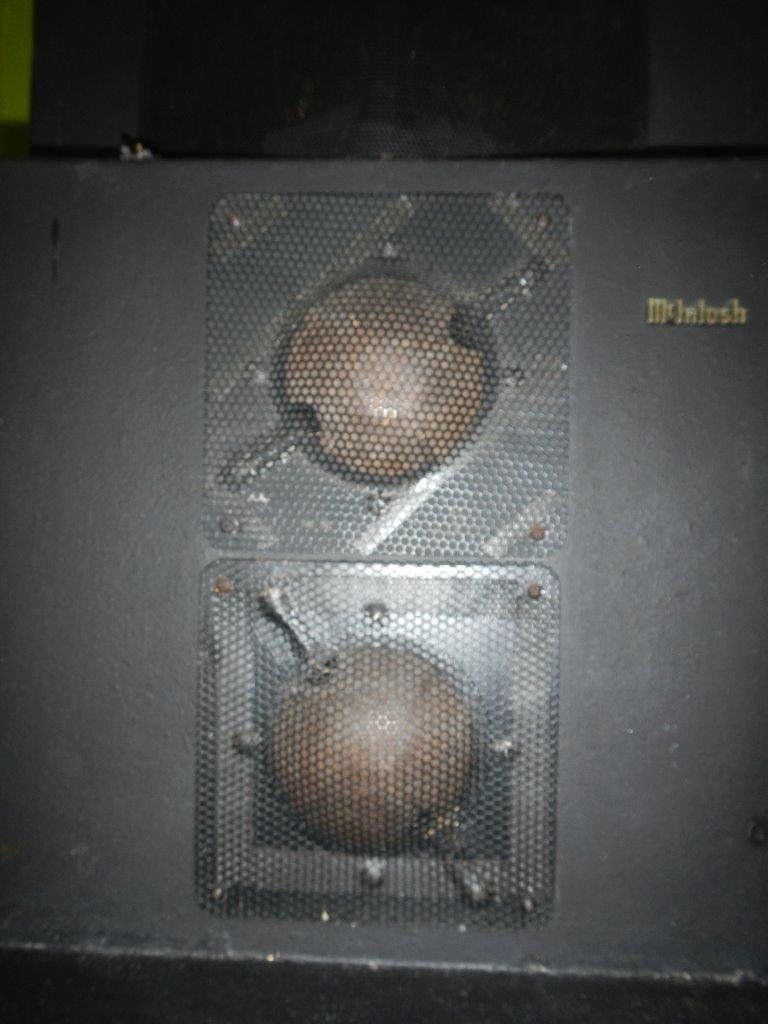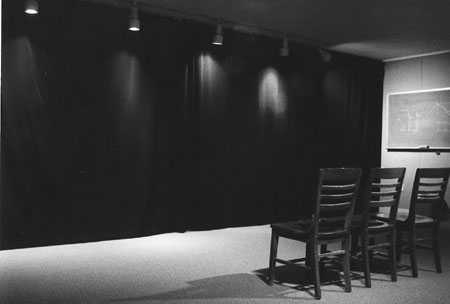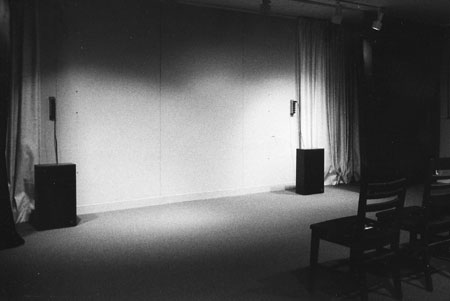McIntosh Loudspeaker Division Part 2
A History (1976 and up)
These pages are copyrighted.
No portion of this site may be reproduced in whole or in part
without written permission of the author.
Listed by year plus additional subjects:
1976
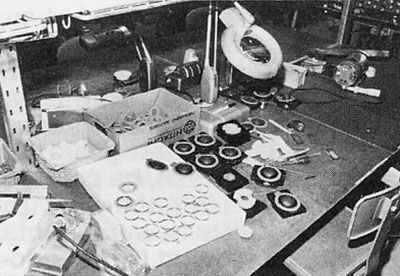 By now we havegained enough experience in speaker
manufacturing to start our own assembly of drivers. The first speaker is the
dome upper mid-range. We use a paper dome with a cotton-phenolic surround to
avoid soft dome patent conflicts with United Speaker Systems. They are first
used in the new XR systems.
By now we havegained enough experience in speaker
manufacturing to start our own assembly of drivers. The first speaker is the
dome upper mid-range. We use a paper dome with a cotton-phenolic surround to
avoid soft dome patent conflicts with United Speaker Systems. They are first
used in the new XR systems.
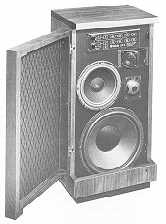 The XR-3, XR-5 and XR-7 replace the ML systems and,
except for a few ML-2 and 4's, are the first systems to be completely assembled
at McIntosh. We purchase the cabinets from a new source. The 5", 8",
10" and 12" drivers are made to our specs by Rola-Jensen in
Punxsutawney, PA. Tweeters are still supplied by Peerless. The crossovers are
made by McIntosh on printed circuit boards. The fuse and light circuits from
the D and N systems are added to the XR's.
The XR-3, XR-5 and XR-7 replace the ML systems and,
except for a few ML-2 and 4's, are the first systems to be completely assembled
at McIntosh. We purchase the cabinets from a new source. The 5", 8",
10" and 12" drivers are made to our specs by Rola-Jensen in
Punxsutawney, PA. Tweeters are still supplied by Peerless. The crossovers are
made by McIntosh on printed circuit boards. The fuse and light circuits from
the D and N systems are added to the XR's.
More features are also added. The crossover board is plugged into a separate compartment enclosed by an aluminum box. It is accessible from the front and is covered with a thick aluminum extrusion that has a block diagram of the crossover network printed on it. The fuses are mounted on this extrusion. The front grille is hinged and can swing to the side. The walnut veneer finish is protected with a clear satin sheen plastic laminate. This provides excellent protection from water stains, cigarette burns and scratches. The red and yellow indicator lights can be easily seen at the bottom right of the cabinet. The red light is above the yellow light.

Here is a close-up of the upper portion of the XR7 system. The fuses are easily accessible on the crossover panel. The four tweeters are mounted in a circular fashion on a plastic form. Perforated metal covers are attached for protection and do not alter the response.. The upper mid-range domes are mounted on an angled form. These two assemblies help to increase dispersion when multiple drivers are used. I used a 24mm lens for this close-up picture.
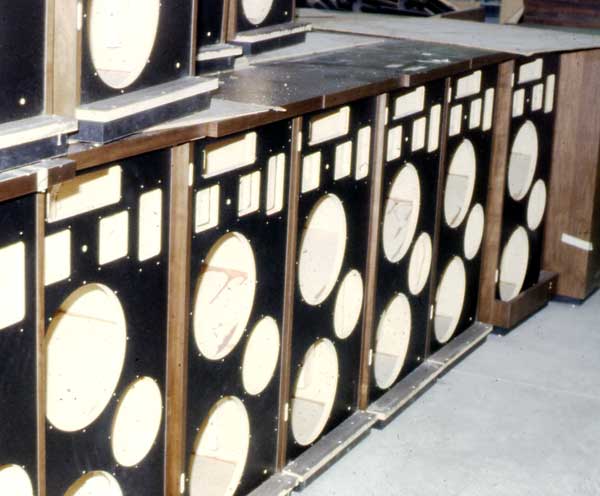
XR7 cabinets ready to be assembled.
 At the left is a system that might have turned into the
XR9, a step above the XR7. It has four 12” woofers, one 8” lower mid-range,
four 1-1/2” upper mid-range domes and four tweeters. The domes and tweeters are
also angled for better dispersion. The crossover prototype is conveniently
located on the top of the cabinet for ease in making changes. I remember
playing Edgar Winter’s “Frankenstein” that this system handles very well,
including the strong mid-range passage. The system never made it to production
At the left is a system that might have turned into the
XR9, a step above the XR7. It has four 12” woofers, one 8” lower mid-range,
four 1-1/2” upper mid-range domes and four tweeters. The domes and tweeters are
also angled for better dispersion. The crossover prototype is conveniently
located on the top of the cabinet for ease in making changes. I remember
playing Edgar Winter’s “Frankenstein” that this system handles very well,
including the strong mid-range passage. The system never made it to production
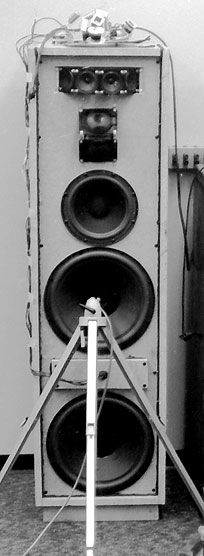 At the right is an alternate design of the XR7. By
mounting all of the drivers in the same vertical line, it has the same response
at the left and right sides, producing better stereo imaging. However, the
system is never produced. A tripod is shown in the picture that is used to hold
the microphone for acoustic tests.
At the right is an alternate design of the XR7. By
mounting all of the drivers in the same vertical line, it has the same response
at the left and right sides, producing better stereo imaging. However, the
system is never produced. A tripod is shown in the picture that is used to hold
the microphone for acoustic tests.
An unusual feature of the XR-3, 5 and 7 is that the tops and bases are removable and can be replaced in case of damage. Also, the systems can be stacked. By removing the top from what would be the bottom system and then removing the base from what would be the top system, they can be attached and present a unified appearance. Some customers and dealers prefer this arrangement.
I am requested to provide sales literature for the XR systems because time is short. I take the pictures with my Nikkormat and a 24mm wide-angle lens. I develop and print the pictures and then write all the text. After printing by Simpsom-Milligan, the finished literature consists of four pages in black, yellow and white. Pictures included the XR5, B&K 3347 real time analyzer, small anechoic chamber, reverberant room, B&K production curve tracer, test bench and equipment, XR5 with grille removed, and XR3, XR5 and XR7 systems. I also write the owner and service manuals for the XR systems. In 1977 the XR6 is added to this literature.
Fiberglass had been used as the acoustic material in the ML speakers. Fiberglass has two good characteristics. It is excellent acoustically and it will not burn. Although this is non-carcinogenic, some production people complain about handling it. We decide to change to a more acceptable material. One of the concerns about selecting a new acoustic material is combustibility. A few speaker companies use urethane pieces in their systems. Gordon Gow learned that urethane can produce poisonous cyanide gas when it burns. Several companies use Doron for acoustic material. It's a synthetic plastic cotton-like material similar to that used in pillows.
One of the reasons for concern about fire is that several amplifiers on the market can supply 30 or 40 volts of direct current to a speaker system if the output transistors fail. This high current can heat the voice coil sufficiently to ignite, particularly if the voice coil form is made of paper or other combustible materials. The main concern is for woofers as there is normally no series crossover capacitor to block the flow of DC. The resistance of the series crossover coil is typically less than one ohm and most of the heating occurs at the woofer voice coil. Gordon Gow learned that a few dealers had an actual fire in their showroom from this cause. One salesman had thrown his cup of coffee on the speaker to put it out. Fortunately it is not due to McIntosh amplifiers or speakers. Underwriters Laboratory approval is not required for speakers.
 I think it best to show what can happen if a
combustible acoustic material is used in a speaker system. Did you ever wonder
how this would burn? In this test Doron is used to fill an XR-5 system and it
is placed in a dirt area outside of our building in Hillcrest. A match is
attached near the center of the woofer cone and ignited, much like what happens
if the voice coil form and spider are to ignite. As a result, the fire from the
cone ignites the Doron and gradually spreads. The entire system eventually
catches fire and is completely destroyed. Impressive! The acoustic material
burns with a vengeance. The 8" speaker in the lower left corner had just
fallen on the ground. You can see the 12" woofer basket outline at the
bottom of the enclosure. The basket and magnet assembly later fall back into
the cabinet. The fire ias so hot it melts the thick aluminum extrusion covering
the crossover.
I think it best to show what can happen if a
combustible acoustic material is used in a speaker system. Did you ever wonder
how this would burn? In this test Doron is used to fill an XR-5 system and it
is placed in a dirt area outside of our building in Hillcrest. A match is
attached near the center of the woofer cone and ignited, much like what happens
if the voice coil form and spider are to ignite. As a result, the fire from the
cone ignites the Doron and gradually spreads. The entire system eventually
catches fire and is completely destroyed. Impressive! The acoustic material
burns with a vengeance. The 8" speaker in the lower left corner had just
fallen on the ground. You can see the 12" woofer basket outline at the
bottom of the enclosure. The basket and magnet assembly later fall back into
the cabinet. The fire ias so hot it melts the thick aluminum extrusion covering
the crossover.
Non-combustible or fire retardant acoustic material is definitely needed for a fiberglass replacement. I decid to use a wood pulp based material that is called Tufflex and require that it be treated with a fire retardant solution. Fire retardant means that the material will burn when placed in a flame but will extinguish when the flame is removed. Later, due to a dust problem, the acoustic material was changed to another fire retardant material.
McIntosh power amplifiers have protection from delivering direct current to a speaker system. The tube amplifiers are protected with the output transformer. Most of the transistor amplifiers are protected with the autoformer. One of the first direct coupled transistor power amplifiers is in the MAC1700. It is modified to protect the speaker by using a triac circuit and internal fuses that will blow in case of output transistor failure.
The XR systems not only have fire retardant acoustic material, but are also protected with a fuse. The fuse protects not only from excessive audio signal power, but also from a high DC current. The ML systems do not have fuse protection, but the McIntosh woofers all have aluminum voice coil forms and the acoustic material in the cabinets is fiberglass.
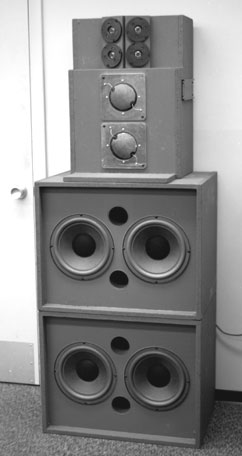 Disco sound has become popular at this time. There is
need for very loud but clean sound for the dance music. Maurice Stereo in
Tampa, FL has requested disco speakers, something that is very efficient and
handles lots of power. Sidney and I visit a dealer in New Jersey that assembles
disco systems for customers. He sends some on loan to us to review. They are
mainly JBL drivers. The 15” woofers are in very large cabinets with horn
loading The tweeters are a cluster of 075 ring radiators that have a notorious
response peak at about 11kHz. I was able to find some of the records the dealer
used to demonstrate his sound at the store. Two songs I remember are Fly Robin
Fly from the album Silver Convention and Donna Summer singing I Feel Love.
Disco sound has become popular at this time. There is
need for very loud but clean sound for the dance music. Maurice Stereo in
Tampa, FL has requested disco speakers, something that is very efficient and
handles lots of power. Sidney and I visit a dealer in New Jersey that assembles
disco systems for customers. He sends some on loan to us to review. They are
mainly JBL drivers. The 15” woofers are in very large cabinets with horn
loading The tweeters are a cluster of 075 ring radiators that have a notorious
response peak at about 11kHz. I was able to find some of the records the dealer
used to demonstrate his sound at the store. Two songs I remember are Fly Robin
Fly from the album Silver Convention and Donna Summer singing I Feel Love.
After evaluating them, I decide that we could build a system that would sound a lot better and still be reasonably efficient. Carl designs a 3” dome mid-range. At first he couldn’t find a suitable paper dome that size and we end up experimenting with wood pulp and water in a blender to make some paper of the right shape. A screen of the right shape can be dipped onto mixture called a “slurry.” and then lifted out. After the water drains out, lo-and-behold—a paper dome! Carl also winds the voice coils for them.
The vented bass cabinets each have two 10” woofers and two vents. The mids are handled with two 3” domes and the high frequencies are handled with four tweeters that are made by Philips. The system works very well and plays very loud. I think 2 pairs are sent to Maurice but the system never goes into production.
The final systems are painted black and grilles with black cloth were made. The mid-range drivers have a perforated metal cover to protect them. This is the same material that is used to cover the Mcintosh 1-1/2” dome. The metal front plate is also painted black.
It is not until the year 2013 that I hear from the new owner in the Tampa area that the systems still exist and are working after all this time. The bass cabinets have been stacked vertically in the lower picture.
|
|
|
1977
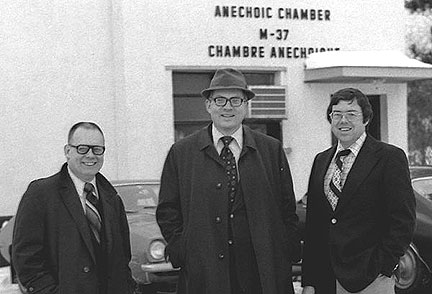
Sidney Corderman, Dirk Roos and I go to Ottawa in Canada to visit with Dr. Floyd Toole, Director of Acoustics Projects and tour the acoustic test facilities This includes their anechoic chamber at the National Research Council (NRC). I always bring my Rolleiflex camera with me on trips like this.
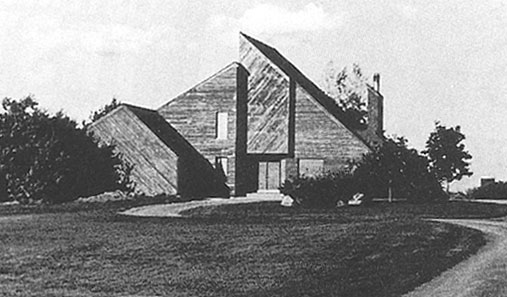
We also have dinner with Floyd and his wife at their home. The house photo is courtesy of High Performance Review magazine, spring 1992. Their 12-room house is in Manotick, Ontario. It is designed and built in 1975 by Floyd and located on a 4.25-acre lot near the Ottawa River. Floyd planned the living room specifically for his audio system. This includes specially selected carpeting and a low noise heating system. As an amateur woodworker, he not only did most of the work himself but also selected the hardwoods used in the house. The woods are selected for their sound reflective properties as well as for their eye appeal. The room rises three stories high to a cathederal ceiling with a clerestory window on one side from a normal 8.5-feeet on the other to break up room resonances. In 1992, Dr Floyd accepts a job at Harman International as the new vice president for acoustic development. The house sells for $525,000.
Floyd agrees to test our XR5 speaker system and the review is written up in the March issue of Audio Scene Canada. In the review, Floyd mentions that the XR5 is “very pleasant to listen to” and that “it is a classic example of a speaker that sounds good until examined under a microscope” indicating that the measurements and the sound are not in agreement. Of course, the measurements that Floyd makes are done in his anechoic chamber, which we do not have, and our design is done in the reverberant room, which Floyd does not have. After this visit, we are convinced that a full sized anechoic chamber will make a valuable addition to our acoustics lab.
As a result of Floyd’s report, Gordon Gow asks me what can be done to improve the XR5 system. I am ready with the answer. The improvement is essentially the same system but with all the drivers in the same vertical line. However, the two Peerless tweeters are replaced with a single Philips soft dome tweeter that has better response, power handling and lower distortion. We find that soft woven textile dome tweeters are far superior to metal and plastic dome tweeters. The vertical arrangement makes the response equal on the left and right sides of the cabinet and this improves the stereo imaging. This is known as the XR-6.
Except for the ML-10, none of the earlier systems are symmetrical. Despite non-symmetry, management decided not to produce a left and right hand version that would have improved imaging to a limited degree. The improvement with the XR-6 is clearly audible and all new designs follow this example. The XR16 is a later version that appears in 1980 with a simpler cabinet and a hard-wired crossover board. It is replaced by the XR17 in 1985.
Several times in the 1970’s I was invited and accepted the opportunity to give lectures to the electrical technology students at our local Broome Community College. I described the fundamentals of designing drivers, enclosures and crossover networks. I brought several driver parts to show. This was followed by a question and answer period and I distributed some of the current McIntosh literature. It was a pleasant surprise for me years later that I have heard from a few of those students who remember my lectures.
As we accumulate more data concerning room environments, it becomes obvious there is more to be done for the speakers in problem rooms.
|
About
Room Resonances |
|
The MQ104 Custom Environmental Equalizer and AA2 Acoustic
Analyzer |
1977
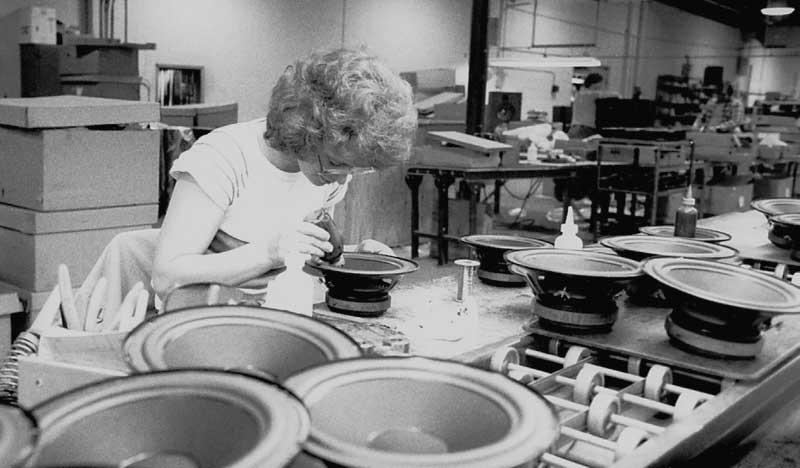
I decid to begin assembling the woofers and mid-range speakers in addition to the 1-1/2" dome speaker. The XRT20 is the first system to use woofers and 8” mid-range speakers made by McIntosh. I am very happy to see all of the drivers made at McIntosh. It meant that we have more control over inspecting the parts as they are received. The drivers are made as needed so only a short time passes before catching any errors, if there are any. I remember one order that came in when we were still buying 8” drivers from the outside. All 1000 pieces came with the wrong magnet and, of course, the wrong response. By making our own drivers, it is possible to make custom speaker assemblies in small quantities that a large manufacturer will not accept. It also avoids possible shipping damage of the drivers on the way to the lab.
Making our own drivers is also a good selling feature for the many visitors and dealers who tour McIntosh production. I do not think many of them have ever seen the actual construction of a driver. The parts and methods used to assemble the drivers must have been a new learning experience for them. It also shows visitors, and even other employees, our competence and expertise to do this kind of work.
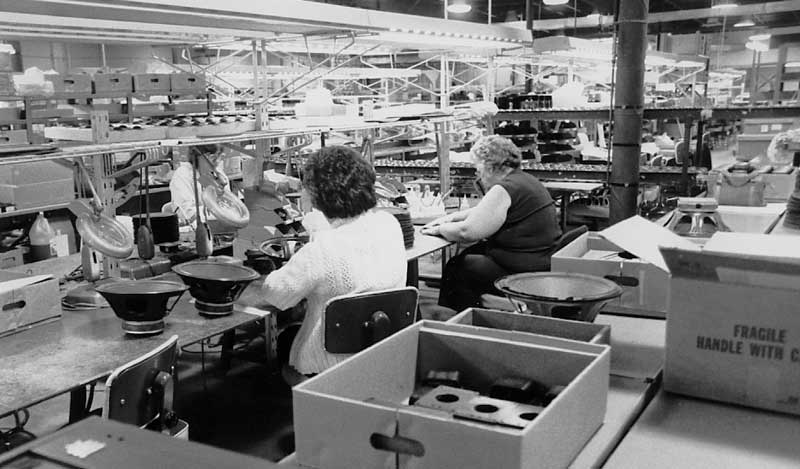
Drivers are also repaired by the production women. At the right side, two early ML woofers can be seen that need the polyurethane surrounds replaced. These are restored using the improved polyether surrounds. In the foreground are the subassemblies for the McIntosh 035 upper mid-range drivers.
The magnetizer that we had used at plant 5 is moved to the main plant for use in production. Various parts and adhesives are purchased from well-known suppliers for the construction of the speakers. Sidney Corderman and I visited several of the suppliers in the Chicago area. We also join Phil Williams, the RDM representative, and tour the cone and surround manufacturing facilities in Cassville, Wisconsin.
1979
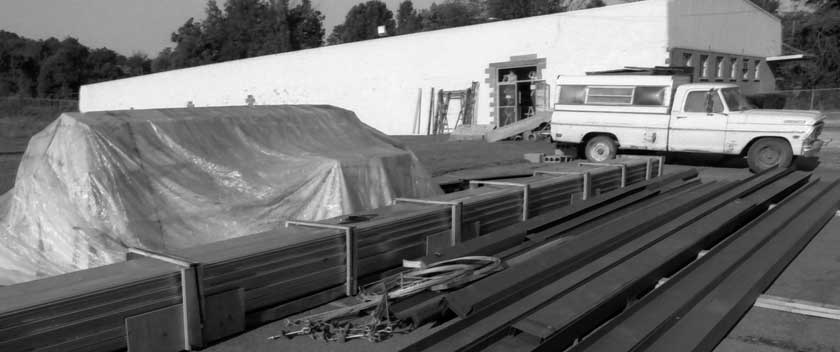
Meanwhile, work begins on Plant 4, just in front of the main plant. It was previously used for printed circuit board assembly and customer service. Prior to that, it was a privately owned bowling alley called Lucky Lanes. It was then purchased by McIntosh. Mr. McIntosh donats the alleys and automatic pin setters to Houghton College located in Upstate New York. This is a major alteration to the building. In the picture, a new double door is being installed. The clear panels in the entrance doors are made of thick polycarbonate that is much stronger than glass.

This is to be the new listening room. It is a larger but correctly proportioned room measuring 21'-6" by 26'-6" and 8'-6" high. Construction ias the same as in the plant 5 listening room. The walls defining the listening room are again concrete block. 2X4’s are spaced away from the wall by half an inch and the space between the 16 inch centers is filled with fiberglass insulation. The walls are then covered with a vinyl clad sheet rock called Durosan. This allows the walls to move at low frequencies and absorb some of the low frequency resonances, much like a typical home construction. A durable carpet without rubber backing is cemented directly to the floor.

In October, plant 4 alterations are completed and the acoustics lab is moved from Hillcrest to the rear two thirds of the building. The view is looking west. The main plant is at the left. An addition to the main plant (center) can be seen in the background. A couple of years later, I purchas 12 acres of the wooded hill, known as High Acres, shown just above the addition. This woods is where I used to spend my lunch time almost every day, summer or winter, rain, snow or sunshine. The hike to the top and beyond is good exercise after sitting at a desk much of the day. Over the years, I find many interesting plants and fossils. I also take lots of pictures.
I am very proud and happy with our new acoustics lab. It is indeed a dream come true for what I had wanted most of my life—the means to satisfy my dedication for creating better sound. It has all of the equipment that Carl and I need to gain even more knowledge of the real world and the truth about acoustics and loudspeakers. We make good use of it.
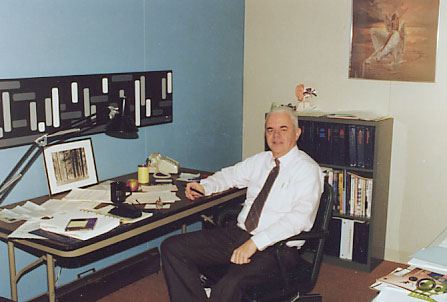
Here I am in my office at my work table. I prefer an incandescent, adjustable lamp for fine work. That is one of my art creations on the blue wall titled “Labels” and under it is a picture taken in my woods. I have a heater under the table as it gets cold in the winter.” My main desk is on the other side of the office.
 On the rear wall of my office is a
print by John Pitre called
“Restrictions. I found this in a print store in a New Jersey shopping mall in
the early 1970s. Since then I have seen several different reproductions and it is
one of the more popular prints of the time. Eventually, I buy several other
prints by this fascinating artist
On the rear wall of my office is a
print by John Pitre called
“Restrictions. I found this in a print store in a New Jersey shopping mall in
the early 1970s. Since then I have seen several different reproductions and it is
one of the more popular prints of the time. Eventually, I buy several other
prints by this fascinating artist
Although the people who comment on this print attributed a variety of meanings, Pitre explains that the rider represents all of us. The horse, Pegasus, the mythical creature of poetic inspiration is symbolic of the vehicles we choose to ride through life-our occupations, goals, loves and dreams.
The silver ropes tethering us to earth are the “restrictions” which temporarily prevent us from flying without limitations to embrace our dreams and goals.
The rider looks skyward with hope and optimism towards a vision of himself, free and unencumbered in the clouds.
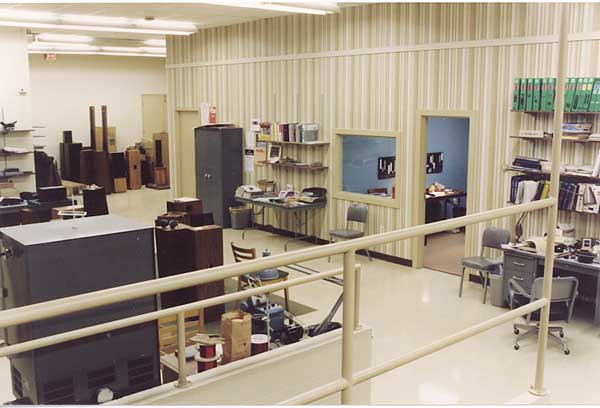
Here’s a picture of the acoustics lab looking from the elevated area where the anechoic chamber is. Carl’s desk is to the right, next to my office. Way in the back, are various competitive speakers and some of our current production models. The railings in the foreground are on either side of the ramp which is used to wheel systems up to the level of the anechoic chamber entrance.
Very soon after moving to the new lab, we find the floor-to-ceiling reflections in the listening room are very unacceptable, despite the carpet. The addition of acoustic tile on the ceiling eliminates this problem. An important addition to the listening room is the curtain installed along one of the long walls. It ias made of pleated black grille cloth and is about 3 feet from the wall. With track lights shining on it, speaker systems cannot be seen through it. The high frequency attenuation is negligible. We can do blind listening tests without knowing which speaker is playing. It is also useful for visitor demonstrations.
You can view a video of the Acoustics lab with me and Jim Carroll on youtube
|
The Anechoic Chamber |
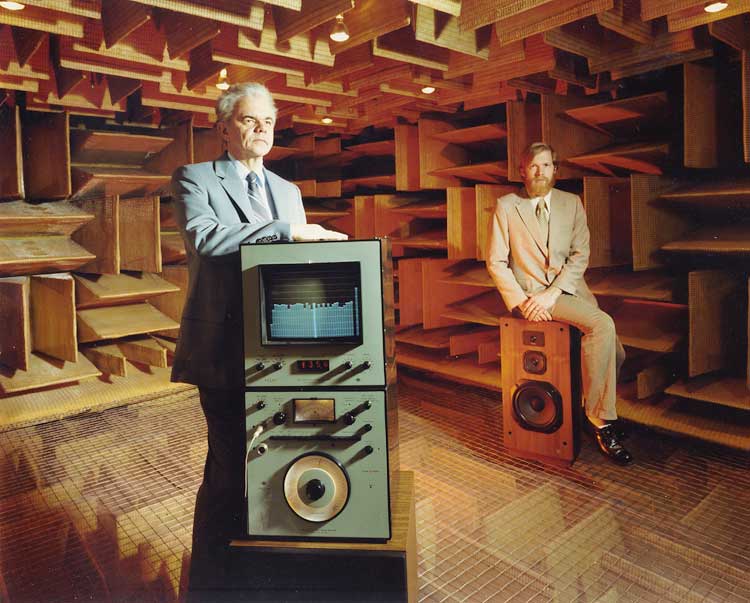
Tony Frontera arranged this picture of Carl and me in our new anechoic chamber. It shows the Bruel & Kjaer 3347 real time analyzer and Carl is sitting on an XD715 speaker system. Some red lights and white spot lights were used for a more dramatic effect. Dave O’Brien liked the picture but I thought it was a little “corny.” We were looking too serious. Carl was looking at the camera but I could have been looking at a bat that was flying around.
Two reverberant rooms were also constructed.
|
The Reverberant
Rooms |
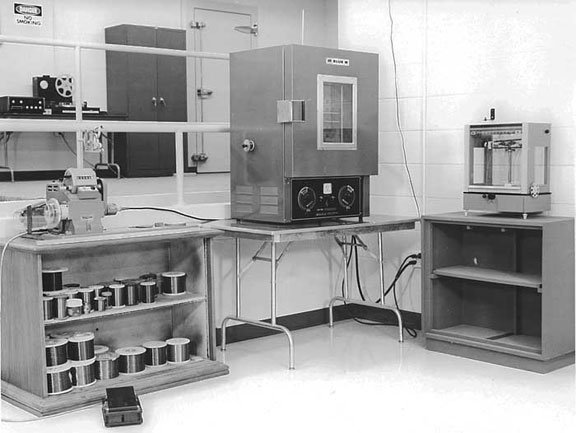
The coil winder is at the left in the picture. I use a reject ML-4M cabinet to hold it and the various wires that we use. A foot switch on the floor controls the speed of the winder. A laboratory oven is in the center. Although it could have been used for baking pizza, it is needed for curing voice coils that have thermal setting cement. A precision balance is on the right. It is used to weigh speaker parts and can weigh very light items down to a milligram. In the rear behind the oven, you can see the anechoic chamber door. It is very heavy steel and requires large hinges to hold it in place. I put up no smoking signs around the lab. Carl and I did not smoke but I want to be sure the visitors do not either.
The laboratory tours continue as before. After showing the visitors the new facilities, I demonstrate our speakers behind the new curtains. I normally explain to the visitors what an important part visual cues play when listening. When these are removed, you concentrate more on the sound and not the size, color or brand of speaker that is playing. After playing a few musical selections, I open the curtains and people are amazed at what they thought was playing compared to what is actually there. They usually admit they thought the speakers are bigger, or they are much further back, etc.
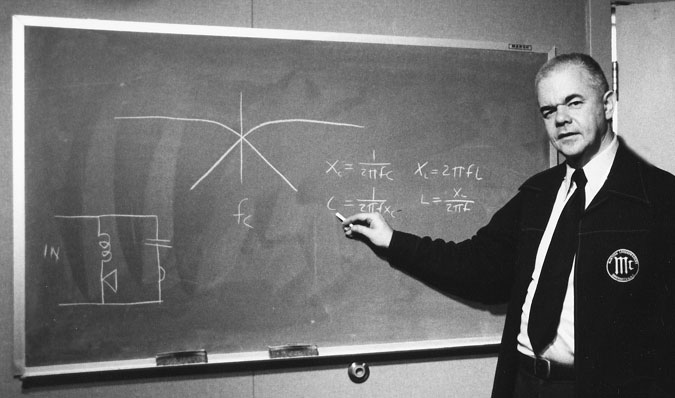
There is also a question and answer period after the demonstration. Here I am explaining some of the fundamentals of crossover design.
Sometimes I set up an A-B comparison for a single visitor. A switch box is used in the audio line to switch both amplifiers and speakers. This avoids contact resistance in the speaker lines. The person is asked to pick which speaker they liked. Some listeners do not understand the purpose of the blind test. They see it as a challenge to tell what the speaker is.
A separate room, including a much needed exhaust fan, is made for the wood working shop. Two large storage rooms are made for the numerous driver samples and parts as well as prototype systems. I have a private office, complete with door and window.
This same year, the XR14 goes into production. It replaces the XR-3. Like the XR-16, the drivers are mounted in line and a single Philips soft dome tweeter iias used. The XD715 is a later version and then the slanted cabinet style XR230 appears in 1990. Design work on the XRT-20 starts at plant 5 in Hillcrest and is completed in our new acoustics lab. In the new chamber we are able to verify the variables involved with the performance of the column and back it up with measurements free from room reflections. The XRT-22 is a later version with some improvements.
One day I am breaking up one of several cabinet samples from a proposed new vendor. I usually do this to check the quality of construction. Lock miter joints are required to give greater strength. The cabinet comes apart fairly easily with a hammer and I discover there is little or no glue holding the cabinet together—only the joints were holding it. I had done this in the wood cutting room. The remaining cabinets are in the front room in Plant 4. When some people came over to see the samples, I pointed out that the cabinets are not well built. There is an overhang on the front board for the cabinet sides. I am able to grab the two sides there and proceed to tear one side of the cabinet off with my bare hands. It is one of those things I could not resist doing and have to laugh at the astonished faces. It sure proved my point about no glue.
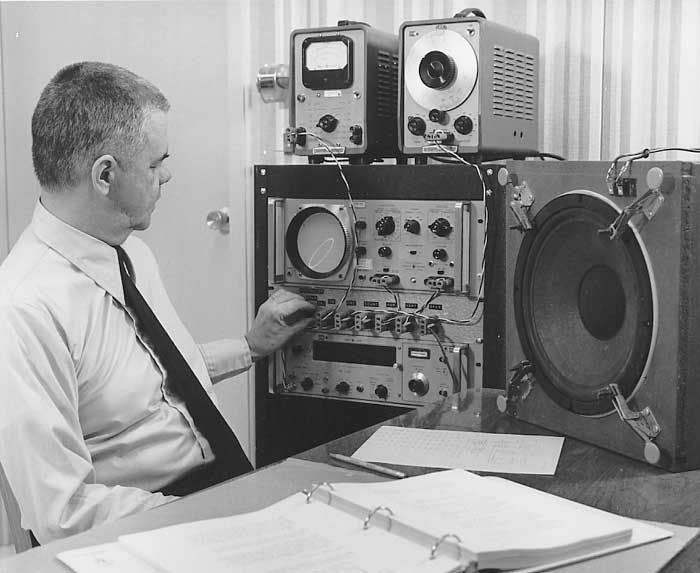
This test setup is used to measure speaker Thiele-Small parameters. It includes an AC voltmeter, oscillator, frequency counter, oscilloscope and test box for the woofer. With this data, the box volume and low frequency performance can be accurately predicted.
|
Design notes on The XRT20 |
|
Speaker Wire: The History |
1981
The XR19 is
produced. It is the same bass cabinet as the XRT20, but without a separate
tweeter column.
|
Design
notes on The XR19 |
1983
 The XR1051 series is first introduced, but development
has been going on for almost two years before it is produced. Carl and I both
have prototypes at home as well as units in the lab. We both do lots of
listening and make many changes, backed up by anechoic and reverberant room
measurements. From this work we gain even better insight into what's really
important for accuracy and listening. Many customers later compliment us on the
extraordinary sound of this system. A later version, the XR1052, appears in
1986 and is essentially the same except for a new cabinet styling and minor
crossover changes. The XR250 then replaces this system in 1991. The 12"
passive radiator and 10" woofer are replaced with two of Carl's LD/HP low
distortion 10" woofers. This is the first system to incorporate the new
woofer technology.
The XR1051 series is first introduced, but development
has been going on for almost two years before it is produced. Carl and I both
have prototypes at home as well as units in the lab. We both do lots of
listening and make many changes, backed up by anechoic and reverberant room
measurements. From this work we gain even better insight into what's really
important for accuracy and listening. Many customers later compliment us on the
extraordinary sound of this system. A later version, the XR1052, appears in
1986 and is essentially the same except for a new cabinet styling and minor
crossover changes. The XR250 then replaces this system in 1991. The 12"
passive radiator and 10" woofer are replaced with two of Carl's LD/HP low
distortion 10" woofers. This is the first system to incorporate the new
woofer technology.
The XL-1 bookshelf system is produced. It is the smallest of the McIntosh speaker systems and has a 1" soft dome tweeter and a 6" woofer. The basis of this system design is later to be used in the initial design of the HT-3 surround sound speaker. Later, the XL-1W bass speaker is introduced to supplement the XL-1.
My violin and bow are used in the photo for some of the XL-1 literature. They are placed on a sheet of black glass for this shot.

Here is another arranged picture that Tony took. I still think it looks a little “corny” but is sort of interesting as well. Perhaps this should be used as a Rodrigues cartoon. The speaker on its side could be called a shoe speaker, although it is supposed to be an XR1051..
1984
The XRT 18 goes
into production at the end of this year. The design time is longer than usual
for this system because of the vertical directivity problems we encounter with
the short column. Our knowledge gained in the anechoic chamber and a computer
program for column design solve the problem of vertical directionality.
|
Design
notes on The XRT18 |
1985
The XL-1W is added
to production this year. It is designed as a supplementary bass speaker for the
XL1's.
|
Design
notes on The XL-1W |
1986
This year the XRT22
goes into production. This is a revised version of the XRT20. The tweeter
column is changed to be a single piece. The grille covers only the front of the
bass cabinet instead of three sides.
|
Design
notes on The XRT22 |
1987
Business Magazine Article
excerpts
An article is written in the January, 1987 issue of Business/New York titled “The Sweet Sounds of Binghamton: Move Over, Osaka. Some of the best stereos are made by the banks of the Susquehanna” by David W. Hollis
“Oh, it is an eclectic concert one hears. Sitting in a plain, straight-back chair in what is meant to be anyone’s living room, the recital ranges from Strauss’ ‘Explosions Polka,’ to the Beach Boys “I get Around.” It finishes with Aaron Copeland’s boastful ‘Fanfare for the Common Man.’
The music cascades from behind a black curtain where you imagine orchestras and rock stars are playing. When the music ends and you wipe the grin off your face, Roger Russell kindly shows you what’s behind the curtain: two loudspeakers. There, in a Binghamton manufacturing plant, sit just two loudspeakers.”
|
|
|
|
This is what he sees when the curtains are closed (left). There are no distractions to interfere with the listening demonstration. After hearing the depth and spaciousness of the music, it is hard to imagine what kind of speakers could be playing. The big surprise, when the curtains are opened, is only a small pair of XL-10’s. Initially, it is hard to relate what is imagined to be there compared to what is really there. |
|
“This is, it should be explained, no ordinary business, and these are not ordinary speakers. This is McIntosh Laboratory, Inc. It makes these speakers and others developed by Russell, director of speaker research and design, and other people.
This is the stuff some audio magazines have called the best; a complete system can cost about the same as a new car, or even as much as a modest home. The company president says many people use it to experience the ‘unfettered mental exercise of music.’…….
……..An example of that kind of product updating can be found in the building just down a slight slope near the main McIntosh plant. This is home to the company’s loudspeaker research operation. Here Roger Russell and Carl VanGelder, an acoustic engineer, lead the way toward new speakers and better sound.
On a tour, VanGelder opens the door to a small room, the anechoic chamber. It looks like the name sounds; like something out of a George Lucas film. Underfoot is a grid of spring-loaded aircraft cable woven together to make a mesh-like floor with a trampoline feel. Below it—in fact, above it and on all sides as well—are large triangular wire mesh cones filled with fiberglass insulation. VanGelder says the room, which cost $250,000, creates no reflections of sound and is used in speaker research. It is, he says, the largest such anechoic chamber in the U.S. used strictly for speaker research.
Not far from it is the reverberant room, a tiled tomb of sorts which creates the opposite effect of the anechoic chamber: seemingly endless echoes. Next to it is the listening room, a large, plain room which simulates an average listening room.
Russell explains this is where the finished product is tested. ‘The speakers are placed behind the curtain so we don’t see what we’re listening to,’ he says.
The goal is to create the “depth and spaciousness” of music heard in a live performance, and do it without a time delay. The latest McIntosh step in that direction is the XRT-22, a loudspeaker on which Russell holds two patents. Briefly, instead of having two cabinets housing the speaker components, the XRT-22 has four cabinets, two per side. One cabinet contains the bass and mid-range elements, while the tweeters –all 23 of them—are stacked in a tall, vertical column. The sound: entirely realistic. The price: $6,600 a pair. It took two years to develop the XRT-22……….”
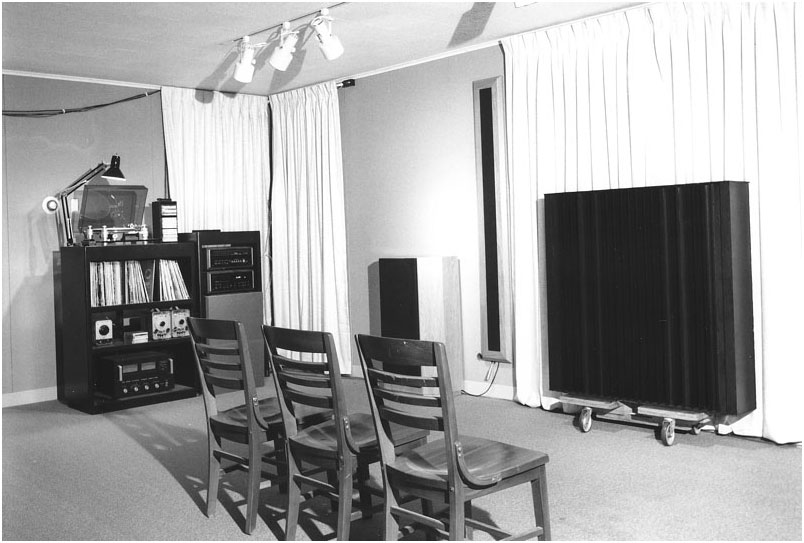
On the opposite wall, pair of oak XRT22 systems are ready to demonstrate. The black box at the right is a diffusion panel used to disperse reflections from the speakers on the curtained wall. This is experimental and is being evaluated. The cabinets on the left contain a turntable and records. There is also a CD player, preamp and power amplifier.
This year production begins on the XD715 and XD717. These systems are later versions of the XR-14 and XR-16. The drivers are purchased from Cotron in Taiwan. The Cotron 1" soft dome tweeter is replaced with the Philips 1" soft dome tweeter in later production. These two systems are replaced in 1990 with the slanted cabinet versions, the XR230 and XR240. The new systems continue to use Cotron woofers and mids. The tweeters are Philips 1" soft domes.
1989

About this time, two salesmen from Hughes came to our acoustics lab at McIntosh to demonstrate the AK-100 Sound Retrieval System (SRS). The Sound retrieval system was invented by Arnold Klayman, a scientist at Hughes, and is based on research by him and others over the years about how we hear. This principle was of particular interest to me. The demonstration consisted of two small speakers on the floor against a wall and a few inches from each other. This is normally not a good location to hear stereo but when the AK-100 was switched in, the sound spread out and the listening position was not critical at all.
Basically, when we listen to stereo with a pair of speakers, sound from the left (L) channel is heard by both left and right ears. The sound from the right (R) channel is also heard by the left and right ears. This is known as stereo crosstalk. A normal stereo program lacks the ability to convey changes to the sound from each channel as it travels to the further side of the human head and is referred to as the head related transfer function (HRTF). This is due to the shape of the head and the outer ear or pinna which act as frequency selective baffles. As a result, the perceived sound stage is usually limited to the front of the room. The SRS combines the two channels to produce a sum signal (L+R) and then subtracts each one from the other to create two difference signals (L-R) and R-L).
The sum signals (L+R) contain all of the direct and centrally positioned sounds. The difference signals (L-R and R-L) provide spacious information and directional cues to the ears. The SRS system addresses the fact that the transfer function of human hearing is not constant. It changes with each degree of azimuth and elevation. For example, sounds coming from straight ahead have a different transfer function, or frequency characteristic than sounds coming from the sides or rear. Aside from other aural cues, such as time of arrival and relative sound intensity at each ear, we use this transfer function to zero in on where the sounds come from.
Stereo speakers only reproduce what the microphones pick up and again that does not account for the transfer function. The SRS can process the difference and sum components from stereo recordings to be similar to how we hear. It creates the illusion that sounds are coming from locations other than the two loudspeakers in front of us. Depending on the source material, it could create a surround sound field approximating that achieved with multiple speakers. However, the question arises whether the SRS system can duplicate what would be heard with a processed stereo recording and headphones compared to a binaural recording and headphones. Bear in mind that the final version of a recording also depends on other factors such as the type and number of microphones, mixing at the recording console and recording engineer. As a result, we end up with yet another alternate reality, albeit pleasing for some listeners. In practice, each recording requires different SRS control settings for Center and Space for the most pleasing results.
The SRS was developed as a system for use by passenger airlines to improve the sound of the in-flight movie and music on airplane headphones. However, it still introduced a way to achieve spacious sound coming from many directions instead of some appearing to come from the center of your head. After positive reviews for the AK-100, word spread among the audiophile magazines. Because the original discrete circuit was very complex, Hughes quickly developed the SRS system as an analog chip incorporated into new or upgraded airline audio systems. It was soon developed for the home as the AK-500. The SRS is particularly useful where speakers have to be relatively close together as in a TV, computer or ipad. However, Hughes was not an audio marketing company with a dealer network. Klayman assembled a group of investors and bought the rights for SRS. He became the director of advanced development for SRS Labs. Several licenses were issued to other companies.

In 1995, a company called NuReality introduced their vivid 3-D theater sound based on the SRS system. There were several different versions varying in price from $59.95 for Vivid 3D to $149.95 for Vivid 3D Studio. This is model VHT-200 and can display center and space information.

A company advertised in 1996 was Spatializer Audio that sold the model HTMS-2510, a 3-D stereo surround processor.
Notes:
When I tried the AK-100 later, with stereo
recordings and relatively small speakers, I found the spacious effect decreased
as the distance between the speakers increased and was virtually non-existent
with speakers in the normal position for stereo listening. In fact, with the
XRT22 speakers in their normal listening position, the AK-100 deteriorated the
sound from their otherwise excellent performance.
The AK-100 can be inserted between a preamplifier and power amplifier in a stereo system. It can also be used in the tape monitor circuit of a receiver or integrated amplifier and is explained further in the owner manual.
The AK-100 was made by Hughes Aircraft Company, 29947 Avendia de las Banderas, Rancho Santana Margarita, CA 92688-2113. It measures 17 inches wide, 11-1/2 inches deep and 4 inches high and weighs about 8-1/4 pounds. The price was $449.00.
The VHT-200 was made by NuReality, 2907 Damier Street, Santa Ana, CA 92705-5810.
The HTMS-2510 was marketed by Spatializer Audio Laboratories, Inc, 453 Ravendale Drive, Suite C, Mountain View, CA 94043
Reviews:
Hughes AK-100 Sound Retrieval System, March 1992 issue of Stereo Review
magazine.
Hughes AK-100 Sound Retrieval System, Decoder April 1992 issue of Audio
magazine.
SRS—What Is It? October 1994 issue of Home Theater magazine.
Psychoacoustics and the Home Theater Experience, April 1995 Home theater
magazine.
NuReality Vivid 3D Theater SRS Processor, April 1996 Audio Magazine.
A more detailed article on hearing is titled
Sounds and Hearing (Part 1) by Roger Russell.
It was published in the October 2007 issue of audioXpress magazine.
----------------------------------------------------------------------------
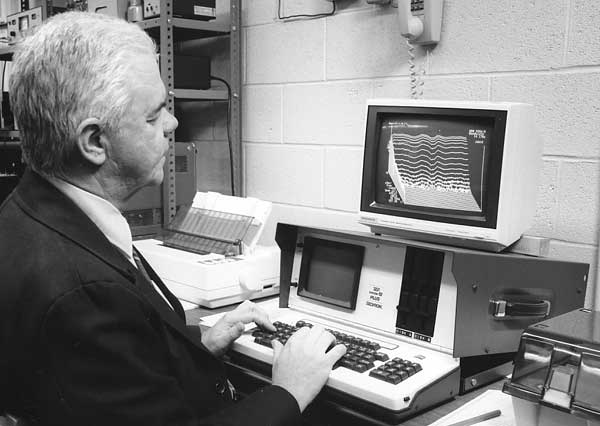
About this time we purchase a TEF (time, energy and frequency) analyzer that enable us to quickly make response measurements for different arrival times in a "waterfall" arrangement. The measurement technique of TDS (time delay spectrometry) is based on the work of Dr. Richard Heyser and is taught by Don Davis and Don Keele. Not only can we see the effect of enclosure reflections and distances versus response, but we can also see the effect of room reflections and path lengths versus response. This unit is also an important design tool used for the LS, HT and SL systems. Although the computer is primitive by today’s standards, it does the job.
![]()
In June of 1989 Gordon Gow passes away peacefully in his sleep on a Sunday afternoon. Maurice Painchaud, who was Vice President and Treasurer, takes on the additional duties as president.
Everyone that knew Gordon Gow misses him. He was a knowledgeable, motivated, generous, fun-to-be-with person. He initiated McIntosh sponsored retailer sales and communication workshops. This included personnel selection, fiscal responsibility, retail management, accounting and other topics. His great desire to better understand the requirements of McIntosh retailers and consumers led to membership in the International Society for General Semantics (ISGS). With his dynamic personality and intense interest, He was soon elected to the board of directors and the office of vice president. He also initiated McIntosh sponsorship of a yearlong study at the University of Michigan to predict future behavior and lifestyles. The program proved to be of great value in the design and marketing of McIntosh products.
Gordon was devoted not only to his work but also to his family, learning and living well. He became well versed in many subjects including knowledge of wine and he even spoke some Italian. He had devoted friends in many countries. He was held in highest esteem in Japan. His reputation as an entertainer was worldwide. At a local Vestal restaurant, Gordon had a specially prepared roast beef menu called "The Gow Cut", and at a Binghamton restaurant had one called "Gow Clams."
I personally feel a very great loss as I shared many of his ideals and learned much from the examples that he set. He understood engineering and I could communicate my work easily with him. I was also a member of the International Society for General Semantics before I came to work for McIntosh and this formed an even stronger tie with him.
![]()
1990
Carl and I begin the design of the
XR290 speaker system this year but it does not go into production until early
1992.
![]()
I am a new age music enthusiast. I have been for many years, going back to the early years of electronic music and the Theremin. The technology of today opens the door to creativity in music that literally has no limit but the imagination of the composer. One of my favorite composers is Ray Lynch.
We often have groups of visitors that I take on tour through the acoustics lab. At the end of the tour, as usual, I demonstrate a pair of McIntosh loudspeakers. They are initially hidden behind the curtains. I play selections of different kinds of music and then open the curtains to show the loudspeakers.
I decide to include one of Ray's pieces called The Oh of Pleasure from his album Deep Breakfast as one of the demonstration pieces. It is very appealing music and is great for demonstrating depth, spaciousness and imaging. Almost invariably someone in the group will ask what it is that I just played. Sometimes they even call me later in the day to ask what it was. This includes our national sales manager, Dirk Roos, who then begins using Deep Breakfast as part of his traveling demonstration. Of course, I explain to those who ask, about the interest people have in Ray's music and mentione his other albums The Sky of Mind and No Blue Thing. As a result, many people, including employees, purchase them and also write to Ray about how much they enjoy his music. Needless to say, exceptional music has a universal appeal and communicates to everyone.
By August, after finding how much interest this music generated, I write to Ray's wife, Kathleen, and tell her what is happening at my speaker demonstrations. She has some nice thoughts about coordinating sales of McIntosh speakers and Ray's albums, which seem like an excellent idea. I pass this on to management. Later, Kathleen sends me a book of outstanding letters from people who have written to say how much Ray's music had helped them. Since then, Ray has made another album titled Nothing Above My Shoulders But the Evening.
![]()
In August, 1990, McIntosh is purchased by Clarion of Japan for 28.6 million dollars. Clarion is a large and well-known manufacturer of car audio equipment. In Japan, McIntosh has the highest reputation for quality and excellence. Clarion expresses its firm commitment to continuing McIntosh philosophies, McIntosh policies, McIntosh management and McIntosh marketing. Also in August, key people, including me, are required to sign a two year contract with Clarion. This is to guarantee that we will remain at McIntosh and continue to do the same work we had been doing prior to the purchase. Later that year, Carl and I are directed by Mr. Shiojiri, the Clarion General Manager of McIntosh, to design our first car system in a Nissan Infiniti Q45.
1991
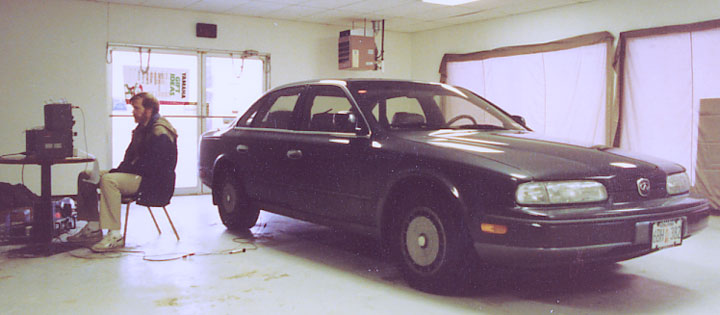
Before a new garage can be constructed, management rents an unused space attached to Pronto’s Restaurant in Conklin, a few miles down the road from the main plant. There are double doors and we are able to drive the Infiniti into the building. It is not heated very well for the middle of winter (January 24, 1991) but it is a beginning. Here is Carl running the chart recorder and sound and vibration analyzer. I prefer to use random noise measurements to minimize resonances and reflections inside the car. Of course, frequency response will be altered if someone is actually sitting in the car.
I later find, when listening with woofers in the rear and tweeters in the front, that the coherence of the sound is poor, perhaps due to the great arrival time and direction difference. When both woofers and tweeters are located in the front or rear, the coherence is audibly improved. Of course, woofers in the rear have the advantage of the large volume of air in the trunk and better bass can be achieved than locating the woofers in the doors with a small volume of air.
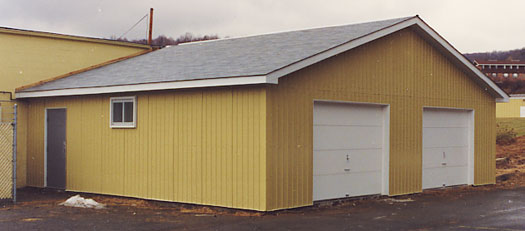
In early January 1991, construction begins on the large two-car garage at McIntosh. It is connected to the acoustics lab so that we can work on car systems with easy access to the lab. The garage is completed at the end of February 1991.
The initial Q45 design is based on our measurement of the drivers and crossovers in the reverberant room. This indicates the total energy of the system regardless of the directional properties of the drivers. When this is mentioned in a progress report to Clarion, response is very negative and we are directed to work only in the car. There is no one who I can explain the need for correlation. They are in Japan and a one-to-one dialog is not possible.
As we work on the car system, I again conclude that this is a step backwards from creating accurate sound. Pleasing sound, of course, is very subjective and I find the sound that the Japanese Clarion people like is not what I like and vice-versa. Although they indicate they are pleased with the results of our first car system, the story changes later. Response measurements are not very useful in this very close and reflecting environment. Moving the microphone from left to right by the distance between the ears changes the response drastically at the mid and higher frequencies. Use of a dummy head could show similar results. It seems that neither measurement nor listening is the answer to pleasing a foreign market.
The next best approximation is to use electronic equalization for one arbitrary microphone location at a point in space between where the ears would be. Of course this is also arbitrary as the ear height varies from person to person. In addition, equalization must be used not only for low frequencies but also above 1 kHz, which is very position sensitive. At least we have maintained a controlled bass response that is not like the boomy one-note bass found in some car systems,
Although Carl and I have what we think is pleasing sound, when the car is actually driven on the road, almost everything is lost in the road noise, despite the fact that the Infiniti has relatively low road noise. The best sound is when the car was not being driven. In the final analysis, the best solution is to have adequate tone control adjustments for the customers so they can adjust the sound to suit their individual preferences. Apparently, exaggerated, boomy bass is one of them.
1992
Carl and I complete the design for the Infiniti Q45 prototype system and the XR290. Carl begins work on the design of McIntosh drivers for car systems. I work on documenting the XR290 for production, including the crossover layout, bill of materials, test procedures, owner's manual and service manual.
The XR250 and the LD/HP woofer go into production. Carl receives a patent for his new woofer design. The XR250 becomes our best smaller system.
|
Design
notes on The XR250 and the LD/HP
woofer |
|
Design
notes on The XR290 |
The second car system we install is in Mr. Shiojiri’s Nissan Maxima. After listening for a while, he is not happy with the sound when sitting in the rear seats. He asks us to improve the sound without any restrictions on how we will accomplish it. Carl and I decide the best place would be to put the speakers near the top of the front seats facing to the rear. This is probably the best sound I had heard so far in a car. I can actually hear some stereo. However, when Mr. Shiojiri sees this, he says we cannot put the speakers there, so that is the end of that. This brings up the question of just what should car sound be like in the first place? How accurate can it be compared to a concert hall performance? Here is some of my early experience with sound in my cars.
I made my own car speaker system back in 1960. It was a big improvement in fidelity compared to the 4" driver in the dash. The new system has better lows and highs. I use an EMI oval woofer and an Electro-Voice T35 tweeter all in a 2 cubic foot enclosure behind the back seat of my Volkswagen. For a previously cheap car system, that is a big improvement. Today, I have come a long way in my search for more accurate sound but that is for homes. Carl and I gain a handle for home systems on the elusive quality of reproducing imaging, depth and spaciousness that is unknown in the days of monophonic sound. Of course, this requires an adequate acoustic environment to play the speakers, such as a well designed listening room. When we are required by Clarion to work on car systems, we find that conditions in a car environment are far from ideal for accurate sound. Perhaps an anechoic chamber on wheels would have been more suitable. I remember being at an Audio Engineering Society presentation of an early car stereo system. The author had the speaker enclosures located in place of the windshield, one on either side and one in the center. However, the visibility for driving was not so good---so much for fidelity in cars. Rule number one is---a car must be a car first and not an accurate sound system.
If fidelity cannot be achieved in car systems, then what is left? Back in 1975, I design a stereo system for my new Toyota Corolla. It consists of a pair of 6X9 woofers with Philips 1" soft dome tweeters. The rear of the woofers is open to the trunk to provide good bass. The drivers face up and the sound bounces off of the sloping rear window. The sound is surprisingly pleasing. All of the sound is diffused from being reflected from the glass. The bass is also strong from, being confined in the small space of the car interior. Of course, I design the system in the reverberant room to have very smooth total energy. The sound in the car is stereo to some degree but it is clean and smooth. It comes from behind instead of the front. If I turn the volume up, it is too loud for long-time listening but stays clean and shakes the body of the car. The amplifier is only six watts per channel! Accurate imaging is not possible but it is still very pleasing. So that is the answer.
![]()
Fortunately, there is the XR290 that has started production. However with the new direction of car systems away from creating better sound for the home systems, the prospect for further improvements is dim. I consider the speaker systems that I had first designed and that Carl and I later design are each works unto themselves. Although they are composed of wood, glue, paper, steel, copper, cloth, plastic and other materials, It is how the materials are used that makes the difference. Carl and I find that as our lab facilities improve, we can spend up to sixty percent or more of our time measuring a new design and making adjustments without ever listening to it. We learn enough to know that each new design has to at least test reasonably in the anechoic chamber and the reverberant room or it is not worth even taking it into the listening room. After that, comes the more exacting part. Each system has its unique characteristics derived from the design requirements—driver size, driver complement, cabinet dimensions, price range, etc. Each system is optimized for these conditions. In the end, each system must do more than just measure good. It is only when listening and measurement are both in agreement that it is acceptable. For example: no system is absolutely smooth. Measurement, both anechoic chamber and reverberant room, is good up to a point but when choosing which of two closely matched response curves is best, listening becomes more important.
When the Clarion people in Japan ask me to list the steps needed to design a system and the time it will take to do each step, my answer is that it depends on what problems we run into as the design progresses. Each system is different with its own set of characteristics to be solved. That answer is totally unacceptable to the Clarion people but it is the truth. It is like asking an artist what steps he takes to create a painting and how long each step will take to finish it or like asking a spelunker how long it will take to explore a new cave. Another part of speaker design is to know when the work is finished and that further effort will not make any more improvements. Each system is, in a way, like a work of art. Like a painting, the artist must know when further dabbling here and there only serves to take away from his creation. Occasionally, I try to dabble with a system that tests and sounds excellent but in the end I realize that the system is finished. So how long does it take to design a new speaker? When no significant improvements can be made! Gordon Gow once said that if you don’t do a thorough job and if all the improvements are not accomplished that could have been done, the competition will do it and you will lose sales.
Deadlines for completion of a system by the new owners can be set with no thought about what is involved and they can be much too short. This invites cutting corners and not doing a thorough job just to satisfy management. This is obviously not a satisfactory procedure. What is most frustrating is that after rushing to complete a system, the deadline is extended and the design criteria have been changed. For me, it is best to proceed at a normal pace and do a thorough job.
Then, in February 1992, Mr. Shiojiri assigns Carl to work exclusively on car speakers and, as a result, he no longer works for me.
In September, Ron Fone becomes the new McIntosh president. He is a very different person compared to Gordon Gow. He signs a four-year contract with Clarion. Maurice Painchaud stays on until May 1992 and then retires. Fone, makes mandatory changes to all the drivers to make them be more like the competition. The appearance of the cabinets is changed for a new look and is created by an artist in Japan. Mr. Fone tells me these changes will involve a sacrifice in performance. This is not in keeping with the McIntosh tradition of excellence. Imagine making the response uneven or increasing the distortion of a McIntosh amplifier just to make it look like the competition.
![]()
The newly styled cabinet samples arrive from Japan for the home speaker systems. They are made of alternate vertical layers of different colored wood. These include the XRT24, XRT26 and the SL systems. Unfortunately, the acoustics of the cabinets and tapered columns are compromised by the new sizes and shapes. I no longer have a say in this. Later, the cabinets develop cracks between the layers and cannot be used. Cabinets similar to the Japanese samples but without the layers of wood are made by a friend of Mr. Fone’s in Brooklyn, NY.
Gordon Gow was very conservative about cabinet appearance and our first designs are made to look mostly like furniture with little consideration for the acoustics. The appearance for later designs gradually shifts with respect to better sound. This change begins when Gordon asks me if I can improve the performance of the XR5 system. The XR5 consists of a 12” woofer, 8” lower mid, 1-1/2” upper mid and a pair of 2-1/4” tweeters that are angled left and right. The drivers are arranged wherever they would fit as in the ML designs. Mirror image pairs (left and right systems) are not acceptable for Gordon. As a result, the response at the left and right sides is different, smearing the stereo image. I have been anxious to fix this since designing the earlier ML-10C system. It is the only one that has all the drivers all in the same vertical line. Now is my chance. I create the XR6 system with the 12” woofer at the bottom, then the 8” lower mid, 1-1/2” upper mid and 1” Philips soft dome tweeter. The single tweeter also contributes to better imaging and can handle more power than the two earlier Peerless tweeters. As a result, the cabinet becomes taller, getting the highs more at ear level. The thinner grille also contributes to better acoustics. This same configuration is used later in the XR16.
Gordon is happy with the appearance. The XR6 begins to look more like a speaker system and less like furniture. As usual, cabinets are always a problem for consistency of quality, including grain matching and price. I consider myself lucky to interest Gordon in my two-piece XRT20 design that is a little radical for a conservative company. However, the sound is outstanding. It is a happy marriage between a satisfactory appearance and good acoustics. I think Gordon realizes that the home furniture style that he started with many years earlier is no longer in fashion for speaker systems and that making a system have better sound means that the appearance has to change. He maintains that if the sound quality does not improve to keep ahead of the competition, sales will suffer and the competition will make the improvements instead.
Loudspeaker design involves three different physical systems, mechanical, electrical and acoustical. In addition to the physical location of the drivers and cabinet acoustics, the sound of a speaker is also influenced by the room acoustics, such as dimensions, construction, furnishings and even where the speakers are located in a room. In comparison, a preamplifier or power amplifier is not affected by room acoustics, dimensions, etc. It is a simple thing to move a volume control or switches around on the front panel of a preamp without any effect on the sound. The appearance can be completely independent of performance and can be given a free hand to take on whatever form is desired.
A happy marriage of acoustics and appearance is the best of both worlds. However for the new president to arbitrarily dictate precedence of cabinet and driver appearance without regard for any listening quality is a step backwards. I often wondered why Mr. Fone never introduces himself to me, although I am considered one of the key people at McIntosh. He never visits the speaker lab until months later when the time comes for a listening evaluation of a speaker. Even then, he never even says hello or wants to see our excellent facilities for research and development—all geared to create improvements in sound. Either Mr. Fone is not informed about my contributions to McIntosh in the past 25 years or he does not want to know or care.
Mr. Fone then hires a friend of his by the name of David Smith, who is out of work, to manage speakers. David later tells me he had interviewed several speaker companies but received no offers. I suggest to Sidney Corderman, who I work for, that my title of Director of Acoustic Research should then be logically reduced to Engineering Assistant or Technician as long as I am consequently assigned to making cabinets and doing measurements for home speakers that I had hired Carl to do many years ago. I also request a new job description for this lower position but these requests never materialize. The new assignment violates the agreement I signed with Clarion that I would continue to do the work I was doing at the time the agreement was signed. The two-year agreement has not expired at this time and I am sure Fone is aware of this. I later learn that I am not the only person whose agreement has been violated by Fone.
![]()
Attempts
to discredit my designs and patents for column and other systems by Smith
persist to this day and deserve a response.
I have been reluctant to reveal the true story about what took place but if I
don't, the truth will never be known.
Apparently my boss, Sidney Corderman, has no say in this recent change. One of the first things the new speaker manager does is to try to alter my design of the XR290, which is now in production. His changes make the system sound bad. His motives appear to be recognition and control. It later occurs to me, when I learn of his motorcycle riding, that perhaps he has acquired a hearing loss in part or all of the frequency range as other motorcyclists have experienced. This in turn may have impaired his hearing ability and affects his competence to make effective listening evaluations. (See my page on Listening and Hearing). He claims to Mr. Shiojiri, the new Japanese manager from Clarion, that he designed the XR290 speaker system, although he had never worked for McIntosh and had no prior connection with McIntosh. When I mention to the Mr. Shiojiri the intent to compromise my design, the change is rejected and the integrity of XR290 is preserved. Mr. Shiojiri has the final say in these matters, even over the president of McIntosh. The XR290 continues in production unchanged from my original design for the next 10 years. Today, it is highly sought after.
Then, the new speaker manager hires a co-op student to spend weeks working on a computer program simulation that attempts to show why the XR290 and other column systems are inferior. It includes the same variables that Carl used to design the XRT18 column back in 1984 but the programming is updated to accommodate newer computer designs. It seems unreasonable to me to degrade a product that is already in production. The report is manipulated to show only bad theoretical aspects of columns. No listening evaluations are included. The report is incorrect and is ignored by both Japanese and American management.
After I leave McIntosh in December of 1992, he goes on to write a paper for the Audio Engineering Society (October 1995). His paper is devoted to computer models and shows a selected set of measurements and mathematical gymnastics. The tests for the paper are based on measurements using sine waves as a test signal. The AES preprint never mentions Carl's name or my name as the source. Apparently he feels our work is free for the taking and that Carl and I are of no consequence. The implications are, of course, that this is all his ideas and accomplishments. After repeated complaints to both him and the Audio Engineering Society, I finally get our credits and names added to the paper when it is published in the journal, November 1997. It acknowledges that it is based on the work Carl and I did many years before but had not published. He still does not acknowledge how a column can work so well, only that his tests show it is full of flaws. He even maintains that I do not understand about columns. Of course, he is entitled to his opinion based on his tests. He seems to be unaware of the precedence effect that explains how we hear. It is either he simply chooses to downgrade my designs or he actually does not have a clue to what is going on with columns. Despite all of this, column designs continue to be used by McIntosh to this day.
Even in the new McIntosh book he persists claiming that he has “revitalized” the McIntosh speaker products. However, the claim he makes is apparently a failure. I learn that the new designs do not sell well and that many remain in the warehouse for several years. This can be one reason why no new designs are made for some time following his departure in 1995.When questioned in a Stereophile interview (Stereophile May 1994, page 98) about the possible sagging of the heavy woofer cones that are facing downwards in his home theater subwoofer system, he stated, "This is not a problem." Apparently, his lack of experience in designing this kind of system creates a problem resulting in higher distortion. The cones continue to sag.
My 1980 patents are referenced by many other companies and I receive many postcards from a patent research company notifying me of the reference. My designs are well received by customers and also by Okie Sugano, a very influential Japanese audio writer. My column designs win awards from Japan for the XR20, XRT 18, XRT22 and XR290. Although the sound of my designs is welcomed by Okie over the years, the changes that Smith makes in the new line of speakers are unacceptable in Japan. In a desperate attempt to get approval, he goes to Japan with systems and crossover parts in an effort to adjust the sound to what the Japanese might like.
![]()
Although, at first, McIntosh bought complete systems from United Speaker Systems, my objective was to build our own drivers. In the mid 1970's. I achieved this goal and we began to make our own drivers. One of the problems in making small quantities of speaker systems was the cost. For a driver manufacturer that is set up to make 10,000 drivers each day, it is an annoyance to set up a production line for 500 or 1000 drivers. The order either is not accepted, the price is very high or production is delayed due to a bigger customer preference. Several times a whole order is received out of spec because a part was changed without our approval. Then we would have to hold up production until the replacements are made and delivered. Making our own drivers avoids production delays, shipping damage and allows unique design features to be incorporated in the construction that the big manufacturers are not interested in doing. The only driver that we do not make is the tweeter. The Philips soft dome tweeter are excellent. Philips has a completely automated production facility that can make one after the other very consistently.
The same goes for the crossover networks. It is hard to get small quantities of assembled networks and get the parts that we want. Instead, the manufacturers use what is best for them. Although I sample from a couple of companies, I cannot get the parts that will meet our specifications. I am able to initiate making our own crossovers and we assemble and test them ourselves.
But McIntosh is again in a financial situation where building our own small quantities has become more expensive than buying finished drivers and crossovers off-the-shelf. That is where we started with United Speaker Systems. After 1992, management decides to buy as much as possible from the outside. Many of the crossovers are then made in Taiwan. The drivers become "stock" off-the-shelf items that anyone else can buy. One exception is the front plates on some of the tweeters. They have a molded "McIntosh" on the front. Some woofers are bought from Vifa and some are made by Phase Tech along with some mid-ranges. This essentially eliminates speaker and crossover production by McIntosh and takes away jobs for the people making them.
I understand that Mr. Fone was previously president of Acoustic Research in Norwood, MA. At that company, he not only had the parts made on the outside but also had some systems designed and produced on the outside by a Japanese company named Tonegen. According to the Mr. Fone, most speaker companies are doing this. The finished systems come into a warehouse from Japan and are then shipped to dealers and are never seen until the customer takes them out of the box. I don't know how true this is. AR eventually is sold to Teledyne, Jensen and then to Recoton in Lake Mary, FL. The Lake Mary facility is now closed as well as the Norwood facility. They are now represented by Audiovox, an international supplier for parts.
![]()
Here are a few things you should know about the Smith systems that replace my earlier designs. The XRT26 goes into production. This system is still based on my patents for the XRT20 and XRT22. However, aluminum dome tweeters are used instead of the soft textile domes. Aluminum dome tweeters are made mandatory by Mr. Fone and typically have a pronounced resonance around 25kHz and soft domes do not. Also, the tweeters use Ferrofluid, which has never been used in McIntosh systems prior to 1992. Several of the tweeters are known to fail due to the Ferrofluid deterioration at high power. See a full explanation and comparison response curves about Aluminum Domes VS Soft fabric Domes. Also, see Stereophile May 1994 page 115 that reviews the McIntosh Home Theater speakers. The reviewer states: "The most visible feature is the pronounced ultrasonic ringing from the strong peak at 26kHz. This is typical of metal-dome tweeters, if slightly more pronounced than most recent examples of the breed."
A tapered width tweeter column is used instead of a constant width column. A nice feature of the XRT20, XRT22 and XR290 is that the same sound can be heard at any listening height. However, the response changes with height for the tapered column resulting in different sound at different height. See more about our research on columns on my XRT20 and XRT22 pages.
Impedance is reduced to 4 ohms instead of 8 ohms. This allows the sensitivity claims to be higher. All systems manufactured prior to 1993 are 8 ohms and have an industry standard sensitivity rating of 1 watt into 8 ohms at a distance of 1 meter. Some systems made after this date are 4 ohms and have a sensitivity rating of 2.83 volts into 4 ohms. This turns out to be 2 watts into 4 ohms, making them appear to have greater sensitivity. To convert to a 1-watt level, subtract 3 dB from the rated sensitivity. For example: the LS350 is a 4-ohm system rated at 89dB for 2.83 volts. This converts to the industry standard rating of 86dB for 1 watt at a distance of 1 meter.
Generally, a 4 ohm speaker will play louder on a direct coupled amplifier than an 8 ohm speaker simply because it draws twice the power with the lower impedance. A few companies have used this strategy for many years. The idea is that when a simple switch arrangement is used in a dealer store to compare different speakers, the louder one is supposed to be the one that gets the sales—and this does help.
However, reducing the speaker impedance to 4 ohms does not improve the accuracy of the speaker, reduce distortion or make any other improvements. However, it does create problems for the customer. It means that the customer must purchase heavier speaker wire to maintain the same low losses compared to the earlier 8-ohm speakers. The total DC resistance of the wire must now be less than 0.4 ohms instead of 0.8 ohms. It also requires better connectors at the speaker and amplifier terminals to make the contact resistance even lower.
Perhaps, as a consequence of higher power being delivered to the 4-ohm systems, the power ratings are arbitrarily increased. All earlier systems are conservatively rated for continuous music listening. My favorite test is to subject a speaker to 8-hour sessions of continuous rock music. An amplifier corresponding to the rated speaker power is driven with the Power Guard indicator red lighting about 50% of the time. For example: the MC7270 is used to power test the 8-ohm XR250 speaker system rated at 250 watts. The first test is with an external crossover to check and adjust components for heat or failure. The second test is with the system complete. Occasionally the MC7270 shuts down from excessive heating but is protected with heat sensors on the heat sinks. After a few minutes it comes on again. Although the power ratings for the new systems have higher numbers, they should be considered as a rating only for occasional short duration peaks and not for continuous music or steady tones. This means that the power Guard indicator on a bigger amplifier should flash red very infrequently or not at all.
A speaker response tolerance is introduced in McIntosh literature. This tolerance of plus or minus so many dB is based on measurements made in the anechoic (reflection free) environment. In fact, it is invariably measured at one position one meter in front of the speaker, right where you do not listen. While I was at McIntosh, I never specified a tolerance as it can be misleading for the customer. The response limits such as 20 to 20kHz indicates that the speaker will reproduce this frequency range. However, a typical home environment is very different from the chamber and can drastically alter the claimed response tolerance. Frequencies below 1000Hz and particularly below 250Hz are influenced by the speaker location, room dimensions, construction and surfaces. This can completely defeat a claim of plus or minus so many dB. In some rooms response peaks and dips can be as much as 15 dB. Even mid-range and high frequency response can be altered by reflecting objects within a few feet of the speakers, including the floor and ceiling. The advertised tolerance is no indication of what the speaker will sound like in your home.
![]()
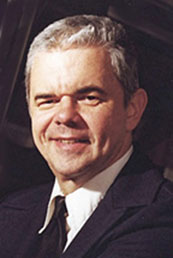
Conditions become increasingly obvious that the new speaker manager does not like the provision that the sound of the speaker systems must meet my approval. That is soon taken away from me by Fone along with everything else. It is also obvious that the new speaker manager attempts to make my work as unpleasant as possible and it comes to the point where I am concerned about the resulting stress. I know that continued upsetting times can take its toll on me both mentally and physically and I value my well being over a good salary. I am certain the new speaker manager has been deliberate in his actions and is overjoyed at my decision to leave and yet at the same time be unable comprehend any conscience or concept of wrong. He keeps trying to impress me with how much he knows. He never asks if I know anything. He even hounds me on my last afternoon at McIntosh to finish the XRT26 column system but I am busy saying goodbye to all of the friends I have made there.
So, in December of 1992, I decide it is time to leave McIntosh. I have been there for 25 years doing the work that I like the most. It has been my home that fulfills my passion and dedication for science, sanity and truth in audio. It has been a dream-come-true. I am very proud to initiate the line of McIntosh loudspeaker systems, improving them over the years, always with an eye to the best sound quality that can be made. I believe I have brought happiness to many people during this time, who love music and have purchased McIntosh speaker systems. Carl and I have spent many enjoyable years discovering the real world of speakers and acoustics. Leaving is a very upsetting and difficult decision to make. My wife and I decide it would be best to sell the house and move away despite having no prospect of future employment. It is no surprise to find that there are no jobs available for a used speaker engineer in Florida. I am never able to find another job and I suspect age is against me, even though I have the advantage of dedication and experience with several aspects of audio over the years. Retirement is still a long way off.
When I leave, I receive no recognition, words of appreciation, or well wishes from any of management for my many contributions that I had made for McIntosh over the years. I remember that Mr. Fone had once said that people who had been there for 25 years should get recognition. Some people say this happens in business where a friend is hired to take over another employee’s job. Although it is easy to understand, it can never be forgotten. Although the explanation may be obvious, reoccurring dreams disguised in various ways show that the memory still remains. Perhaps it is like the movie Forbidden Planet where monsters from the id (subconscious) emerge in dreams.
During my stay at McIntosh, and also while at Sonotone, I meet and talk with many notable people in the audio industry. This includes Ben Bauer, Rudy Bozak, Victor Brociner, Abe Cohen, Ray Dolby, Richard Dorf, Dr. Harvey Fletcher, Julian Hirsch, Larry Klein, Paul Klipsch, Dr. Harry Olson, Ed Villchur, Paul Voigt, Dan Von Recklinghausen, Bert Whyte and of course Gordon Gow and Frank McIntosh.
Also during this time, I write several more magazine articles about electronics, speaker design and speaker measurement for Popular Electronics, Radio-TV News, Electronics World, Audio Amateur and Speaker Builder. Later, I also write articles for audioXpress and a series of articles about mystery clocks that are published in the National Association of Watch & Clock Collector’s Bulletin.
The best systems have my column designs that go from floor to ceiling with many drivers covering the same frequency range such as the XRT20, XRT22 and XR290. Low distortion can be maintained even with high power input to the system. I am pleased to see that my concept of column designs and patents continues to be used by McIntosh in the top-of-the-line speaker systems. The benefits are still recognized and used to this day. I recently have written about My Experience With Column Systems.
One of the wonderful things about working at McIntosh and Gordon Gow was the freedom to create new designs. Of course, these designs are often to meet certain marketing requirements, such as size or price range, but the way is open for how to accomplish these goals. There are no deadlines. Other designs such as the XRT20 and XR1051 are initiated entirely by me to meet my own goals. When completed they are enthusiastically received by Gordon Gow as very marketable and go into production. It all goes to prove that rigid procedures and timetables, required by Japanese management, are not always the best way to achieve innovative designs and allow for engineering thoroughness. Of course, with freedom comes responsibility but that is not a problem for a dedicated person. As far as I know, no new patents have been awarded to McIntosh since the Japanese took over.
While at McIntosh, my designs are essentially unchanged from the finished prototypes to when they go into production, with a little help from me. How many of you have read the book "The Fountainhead" by Ayn Rand or even seen the movie? It deals with the individual versus the collective and is reminiscent of the situation at the lab starting in 1992. The new McIntosh president, Mr. Fone, wants designs that are more mainstream and that have drivers that are like those used by other companies and cabinets that are designed without regard for good acoustics (the collective). It violates the McIntosh tradition of making the best possible sound, whether it is in electronics or loudspeakers.
The 4-year contract for the McIntosh president is not renewed by Clarion in 1995 and Mr. Fone goes on to a.d.s. Smith soon follows to the same company. Fone never sells his house in the Boston area all that time he is at McIntosh. I hear that he and his friend only last for a year at that company and the real reasons for leaving are not clear. It is rumored that the owners of the company let them go. One dealer said that the employees at a.d.s. gathered in the parking lot one day to protest about Mr. Fone. Meanwhile, the ex-speaker manager continues to use aluminum domes at yet another company. A review in The Absolute Sound (October/November 2002) of the Snell XA Reference Loudspeaker ($25,000) has this to say: "Finally, the metal dome tweeter has a slight hint of metal sweetness below, sharpness above that is characteristic of aluminum domes, even though it's resonance is far out of the audio band, and indeed the high treble within the audio band droops a little (not a serious problem, of course)." The ex-speaker manager makes no reply to this in the Manufacturer's Comments column.
In the years following, I learn that several other people have also left McIntosh because of Fone’s abrasive and unreasonable behavior that I can only describe as childish tantrums. This behavior includes alienation of several loyal dealers that I am later in touch with. Before I leave, Fone calls me one day and is ranting and raving to me about a rubber ring from a speaker that is on loan from a dealer. It has been sent to Taiwan to be duplicated. Of course, I know nothing about it as it has done by someone in the engineering department at plant 6 only because Fone wants it duplicated. He never asks if I sent it. I get the impression that if I say the sky is blue, he will dispute it. It is not only me that has encounters with Fone. His favorite in meetings is to ridicule and degrade various employees in front of the others by what I now realize is termed bullying and he is in a position to get away with it. His favorite judgment for employees is “inexcusable” or “unforgivable.” The term industrial bullying is something new to me and apparently is similar to bullying in schools. It seems that this is not new in the workplace.
In 1993,. Sidney Corderman becomes temporary President. In December, Thomas Shaeffer becomes the new President.
In 1997, Pete Stethers is hired to work full time with Carl Van Gelder. Pete has previously been employed as a Rochester Institute of Technology co-op student working in the loudspeaker division at McIntosh. Carl and Pete continue with the loudspeaker research and development.
Despite all of this, if events had not taken place as they did and with the help of a few friends, I might never have created the IDS-25 speaker system ten years later. This turned out to be the most accurate of all the speakers I designed. It won high praise at several shows and demonstrations.
This is the end of my history about the Loudspeaker
Division at this time but it is a new beginning for me.
I hope to add more information, time permitting.
For recent literature about McIntosh loudspeakers, you might check the McIntosh
page.
![]()
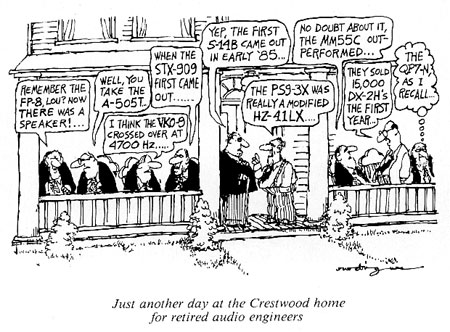
Courtesy of Rodrigues
2005
After 55 years of accumulating
knowledge and experience as an audio enthusiast, my dedication for better sound
is undiminished. In 2002, ten years after leaving McIntosh, I make the first
prototype of my dream system. This concept is something I always wanted to try.
My experience with column systems and patents make this possible. I find some
inexpensive drivers with adequate response that can be used to verify that my
concept of a new column will work. It works very well and an article about this
prototype system is published in the November 2005 issue of audioXpress
magazine. The sound is so captivating that I cannot resist building an improved
version with components, including drivers, having the best of technology as
well as performance. Of course, it is a risk because the cost is much greater
than my first set of columns.
Then, I realize that the improved version I have created provides greater accuracy than anything I have heard before. The concept, although somewhat radical in design, turns out to be astonishing in performance. I think Gordon Gow would have been very enthusiastic if he had been able to hear it. The accuracy in imaging, depth and spaciousness is outstanding and it provides an unprecedented coherence to the sound that is unique to my design. A second article about the revised version is in the July 2006 issue of audioXpress.
The system is shown at the 2006 Rocky Mountain Audio Fest and receives excellent reviews. The room is very crowded each of the three days. The proof is in the listening and we receive many complements from the attendees. It is available as the IDS-25 Stereo Loudspeaker System.
![]()
My Life in the Audio Engineering Society
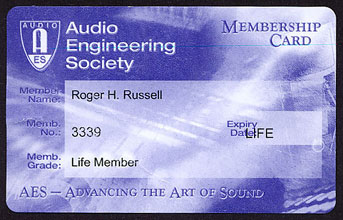
In 2008, I have been awarded a life membership in the Audio Engineering Society.
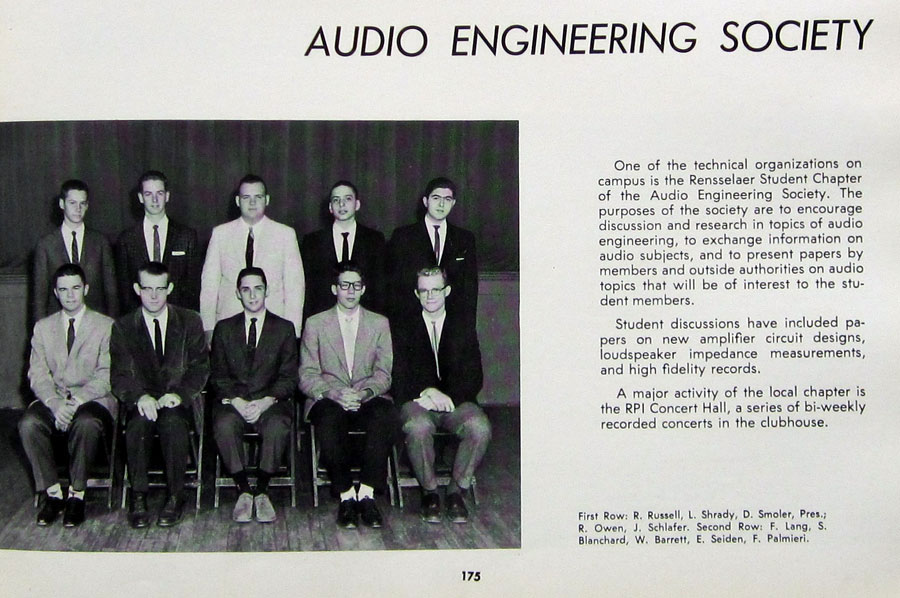
I was a
student member of the AES at Rensselaer Polytechnic Institute.
This picture is from my 1959 graduation yearbook.
The student meetings and music sessions were very enjoyable.
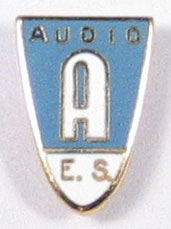 In 1959 I began work as a senior engineer in the Audio
Products Division at the Sonotone Corporation,
in Elmsford, NY. At that time I became a full member of the AES and purchased
this lapel pin. My work includes design of several sealed and vented speaker
systems and a variety of omnidirectional, cardioid and noise cancelling
microphones. I also write my first two magazine articles.
In 1959 I began work as a senior engineer in the Audio
Products Division at the Sonotone Corporation,
in Elmsford, NY. At that time I became a full member of the AES and purchased
this lapel pin. My work includes design of several sealed and vented speaker
systems and a variety of omnidirectional, cardioid and noise cancelling
microphones. I also write my first two magazine articles.
During that time, I attend many AES conventions in New York City and that is where I first become acquainted with Julian Hirsch, Victor Brociner and Paul Voigt. I also attend several AES tours such as Consumer Union and the Bozak factory.
In 1967, I begin working at McIntosh and in a few years become Director of Acoustic Research.
![]()
|
About This Site |
||
|
|
Any comments, corrections, or additions are welcome. |
|
|
|
Created
by Roger Russell |
|

